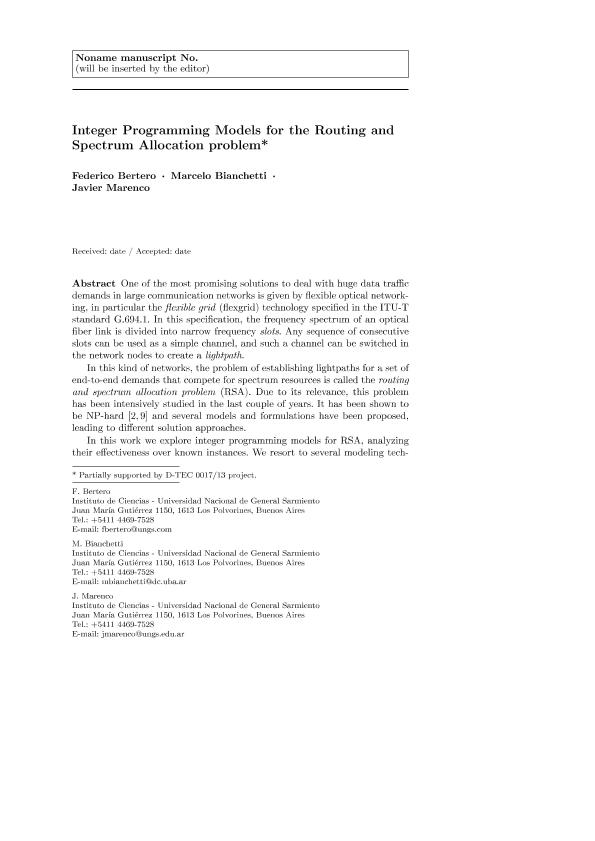Mostrar el registro sencillo del ítem
dc.contributor.author
Bertero, Federico Alberto

dc.contributor.author
Bianchetti, Marcelo

dc.contributor.author
Marenco, Javier Leonardo

dc.date.available
2020-02-20T23:23:41Z
dc.date.issued
2018-10
dc.identifier.citation
Bertero, Federico Alberto; Bianchetti, Marcelo; Marenco, Javier Leonardo; Integer programming models for the routing and spectrum allocation problem; Springer; Top; 26; 3; 10-2018; 465-488
dc.identifier.issn
1134-5764
dc.identifier.uri
http://hdl.handle.net/11336/98247
dc.description.abstract
One of the most promising solutions to deal with huge data traffic demands in large communication networks is given by flexible optical networking, in particular the flexible grid (flexgrid) technology specified in the ITU-T standard G.694.1. In this specification, the frequency spectrum of an optical fiber link is divided into narrow frequency slots. Any sequence of consecutive slots can be used as a simple channel, and such a channel can be switched in the network nodes to create a lightpath. In this kind of networks, the problem of establishing lightpaths for a set of end-to-end demands that compete for spectrum resources is called the routing and spectrum allocation problem (RSA). Due to its relevance, this problem has been intensively studied in the last couple of years. It has been shown to be NP-hard (Christodoulopoulos et al. in IEEE J Lightw Technol 29(9):1354–1366, 2011; Wang et al. in IEEE J Opt Commun Netw 4(11):906–917, 2012) and several models and formulations have been proposed, leading to different solution approaches. In this work, we explore integer programming models for RSA, analyzing their effectiveness over known instances. We resort to several modeling techniques, to find natural formulations of this problem. Since integer programming techniques are known to provide successful practical approaches for several combinatorial optimization problems, the aim of this work is to explore a similar approach for RSA.
dc.format
application/pdf
dc.language.iso
eng
dc.publisher
Springer

dc.rights
info:eu-repo/semantics/openAccess
dc.rights.uri
https://creativecommons.org/licenses/by-nc-sa/2.5/ar/
dc.subject
FLEXGRID OPTICAL NETWORKS
dc.subject
INTEGER PROGRAMMING
dc.subject
NETWORKS
dc.subject
ROUTING AND SPECTRUM ALLOCATION
dc.subject.classification
Ciencias de la Computación

dc.subject.classification
Ciencias de la Computación e Información

dc.subject.classification
CIENCIAS NATURALES Y EXACTAS

dc.title
Integer programming models for the routing and spectrum allocation problem
dc.type
info:eu-repo/semantics/article
dc.type
info:ar-repo/semantics/artículo
dc.type
info:eu-repo/semantics/publishedVersion
dc.date.updated
2020-02-18T16:06:56Z
dc.journal.volume
26
dc.journal.number
3
dc.journal.pagination
465-488
dc.journal.pais
Alemania

dc.journal.ciudad
Berlín
dc.description.fil
Fil: Bertero, Federico Alberto. Universidad Nacional de General Sarmiento. Instituto de Ciencias; Argentina. Consejo Nacional de Investigaciones Científicas y Técnicas; Argentina
dc.description.fil
Fil: Bianchetti, Marcelo. Universidad Nacional de General Sarmiento. Instituto de Ciencias; Argentina. Consejo Nacional de Investigaciones Científicas y Técnicas; Argentina
dc.description.fil
Fil: Marenco, Javier Leonardo. Universidad Nacional de General Sarmiento. Instituto de Ciencias; Argentina
dc.journal.title
Top

dc.relation.alternativeid
info:eu-repo/semantics/altIdentifier/url/https://link.springer.com/article/10.1007/s11750-018-0483-6
dc.relation.alternativeid
info:eu-repo/semantics/altIdentifier/doi/http://dx.doi.org/10.1007/s11750-018-0483-6
Archivos asociados
